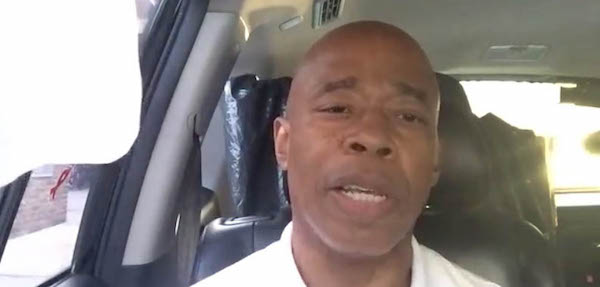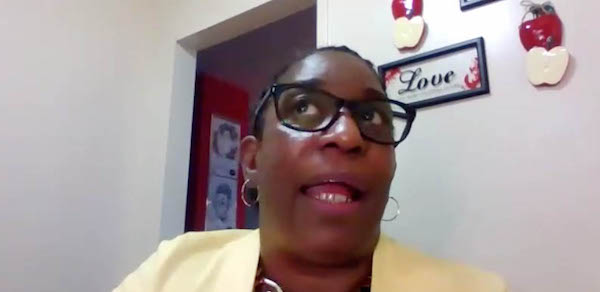
BY DONATHAN SALKALN | Open to the public, interactive, and held online via Zoom, the July 16 meeting of the Chelsea Reform Democratic Club (CRDC) brought together four powerful, independent voices intimate to the Black Lives Matter (BLM) movement.
Co-hosted by CRDC Exec VP Charles Bayor and CRDC President Mindy Rosier-Rayburn (who also served as moderator), the guests Brooklyn Borough President Eric Adams (BP Adams), Janella Hinds (VP of Academic High Schools, United Federation of Teachers), Luana Green (Chelsea-based community activist), and Charles Khan (Organizing Director, Strong Economy for All Coalition).

Joining the proceedings from a parked automobile (not-uncommon in the age of pandemic-necessitated Zoom meetings), BP Adams brought his work in law enforcement and government to the Black Lives Matter discussion.
Adams’ 22-year law enforcement career began when he became a high-ranking member of the NYPD Police Academy’s Class of 1984. That path to public service was set nearly a decade earlier, when the 15-year-old and his brothers were beaten by NYPD police officers. Just over a decade later, in 1995, Officer Adams co-founded 100 Blacks in Law Enforcement Who Care, an advocacy group that achieved national recognition and influence. Adams shared with the Zoom audience another enormously influential event—the 1984 shotgun shooting death of elderly, disabled African American public housing tenant Eleanor Bumpur, whose demise was the result of a botched eviction.
“That was the moment I knew I had a purpose to be in the Police Department—and after leaving and going to the State Senate, I continued that pursuit, and continue it now as Brooklyn Borough President,” said Adams, who rose to Captain within the NYPD.
Before discussing NYPD reform scenarios, Adams tied the city’s ability to adapt and better itself to its belief that such a thing is possible.
“We have become complacent,” opined Adams. “During the eighties and nineties, we thought we could only live in a crime-ridden city. And we are there again. We don’t believe, for the most part, we can deal with the homeless. We don’t believe we can actually have affordable housing. We need to look at ourselves in hope that this city is moving forward.”
Our police department, said Adams, “could be so much better.” He offered changes that would put more police officers on the street, while saving money that included remote testimony of officers in court cases which would also cut down on overtime, removing the paperwork of traffic accidents, and eliminating police officers from working the switchboards.
“We need to build an ecosystem that’s a combination of not only men and women who wear blue uniforms, but everyday young people who wear blue jeans,” Adams told the Zoom audience. He explained how society spends too much time and money pulling people out from “the river of crime” instead of investing time and money in tackling the problem upstream.
“Look at Rikers Island,” Adams pointed out. “Eighty percent of the inmates don’t have a high school diploma or equivalency diploma. Fifty-five percent of the men and women have a learning disability.”
Adams proposed to use some the $1.4 billion in NYPD budget savings in getting the proper care and for those children who have learning disabilities, or those with mental illness. “If we do that,” he said, “we would be proactive in addressing the issues of crime… I say we focus upstream so people won’t fall into the river of the crime pipeline that feeds the Rikers Island Prison Complex.”

Joining the dialogue was United Federation of Teachers’ Janella Hinds, who advocated for more money invested in schools located in poor communities.
“When we think about NYC public education we think about the haves and have-nots,” said Hinds. “There are schools that have tons of resources and have much opportunity provided. We also know there are schools that are lacking, and in great need, and do not have access or opportunity to some of the basic offerings that NYC should be providing to all students.” COVID-19, noted Hinds, exposed the lack of Wi-Fi and other high-tech resources for some children to participate in remote learning.”
For some children, said Hinds, school is “their sanctuary, and home is not a safe spot. Home isn’t where they are fed, and loved, and where they are seen. It is no longer acceptable to have low expectations of students with disabilities, or who live in public housing, or have parents who are incarcerated, or students that are Black, or Latino, or immigrant. There’s work to be done!”
That work, said Hinds, is not of importance because “Black Lives matter more. It’s about acknowledging that black lives matter. Unless Black lives matter, you can’t say all lives matter.”


Charles Khan, of Strong Economy for All Coalition, has been a leader in the effort to defund the NYPD, and was a major architect of Occupy City Hall (#OccupyCityHall).
“We called for Occupy City Hall on June 23rd to defund the police of a billion dollars, and to remove the police from our schools,” noted Khan. “It is based on the fact that police can’t make our communities safe. If you look at communities that are considered safe, they have access to high-paying jobs, affordable housing, the best schools in the country, and health care. Strong communities are safe communities.”
Defunding the police, said Khan, “is an act to defund an institution that is both harmful and violent towards black people, people of color, and poor people. If you show up with a gun and baton after a few months of training, the solution is very limited.”
There needs to be “a reallocation of money to communities in need. Million dollar homes are alongside people who can’t afford their rent,” said Khan, adding, “The Police Department is systematically harmful. If you’re a black officer or brown officer and you’re arresting teenagers for jumping a turnstile, that is a deeply problematic practice. It doesn’t matter if you are black or brown because the police system is so corrupt. When we think about police solutions it’s not just diversity or training.
Recalling earlier in the program, when BP Adams said increased mental health and development funding would pay off in the form of preventative crime-fighting, Khan called for “a reallocation of money to communities in need.” Our focus, he insisted, “should be upstream [before the city’s youth and vulnerable fall into the river of crime].”
Click here to access the BLM website. Click here to access the CRDC website’s BLM-dedicated page. To access a recording of the entire program, click here.
Chelsea Community News is made possible with the help of our awesome advertisers, and the support of our readers. If you like what you see, please consider taking part in our GoFundMe campaign (click here). To make a direct donation, give feedback, or send a Letter to the Editor, email scott@chelseacommunitynews.com.

Pingback: พรมรถ
Pingback: next page
Pingback: โรงแรมสุนัขเข้าได้
Pingback: Dave Bolno
Pingback: recommended you read
Pingback: Recommended Reading
Pingback: ฝาก ถอนเงิน สล็อตวอเลท ไม่มีขั้นต่ำ
Pingback: Tropical Punch 1g Disposable Vape
Pingback: london event filming company
Pingback: where to buy shroom chocolates near me
Pingback: yabo
Pingback: click here for info
Pingback: sbobet
Pingback: 토토세콤
Pingback: Alquiler de trasteros
Pingback: valid cvv shop
Pingback: buy ayahuasca tea online delivery,
Pingback: maxbet
Pingback: Darknet Market
Pingback: click for more info
Pingback: cvv dump sites
Pingback: nova88
Pingback: สล็อตวอเลท
Pingback: Esport
Pingback: www.find-hookups.net/local-sex-chat/
Pingback: Marijuana shop Near Me
Pingback: vice city market url
Pingback: fake navitimer world
Pingback: sell my home
Pingback: benelli supernova tactical